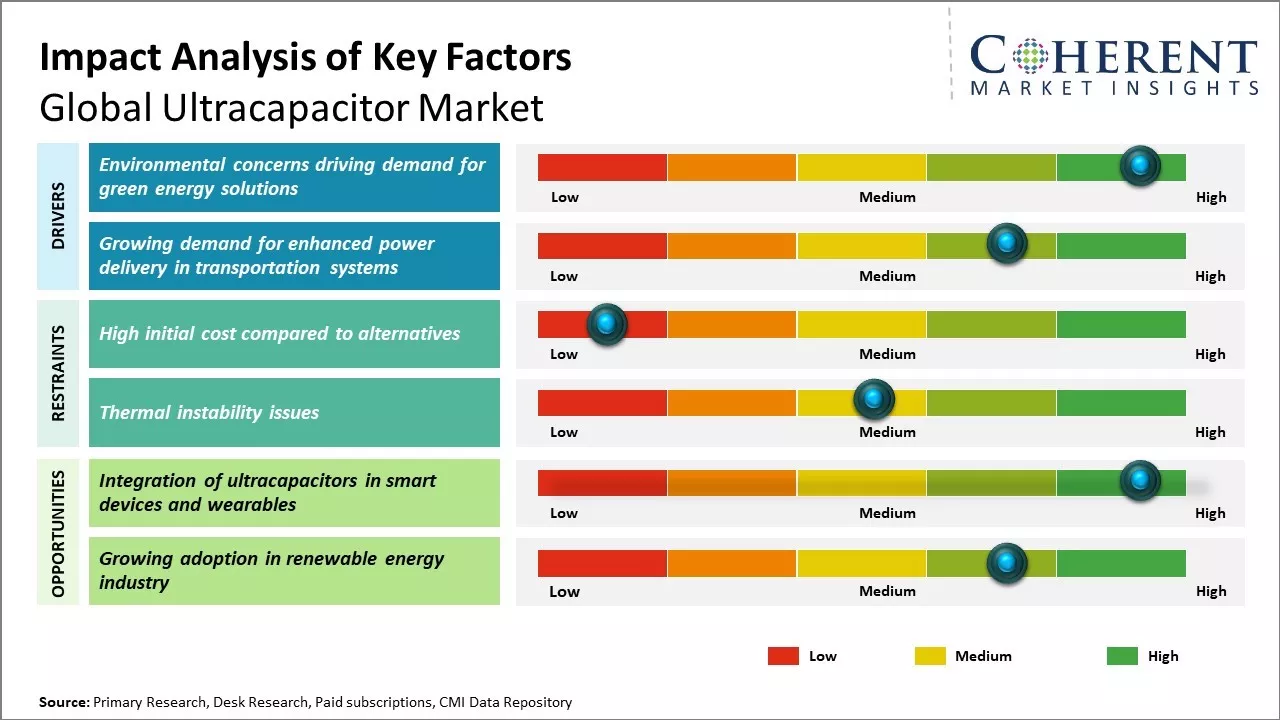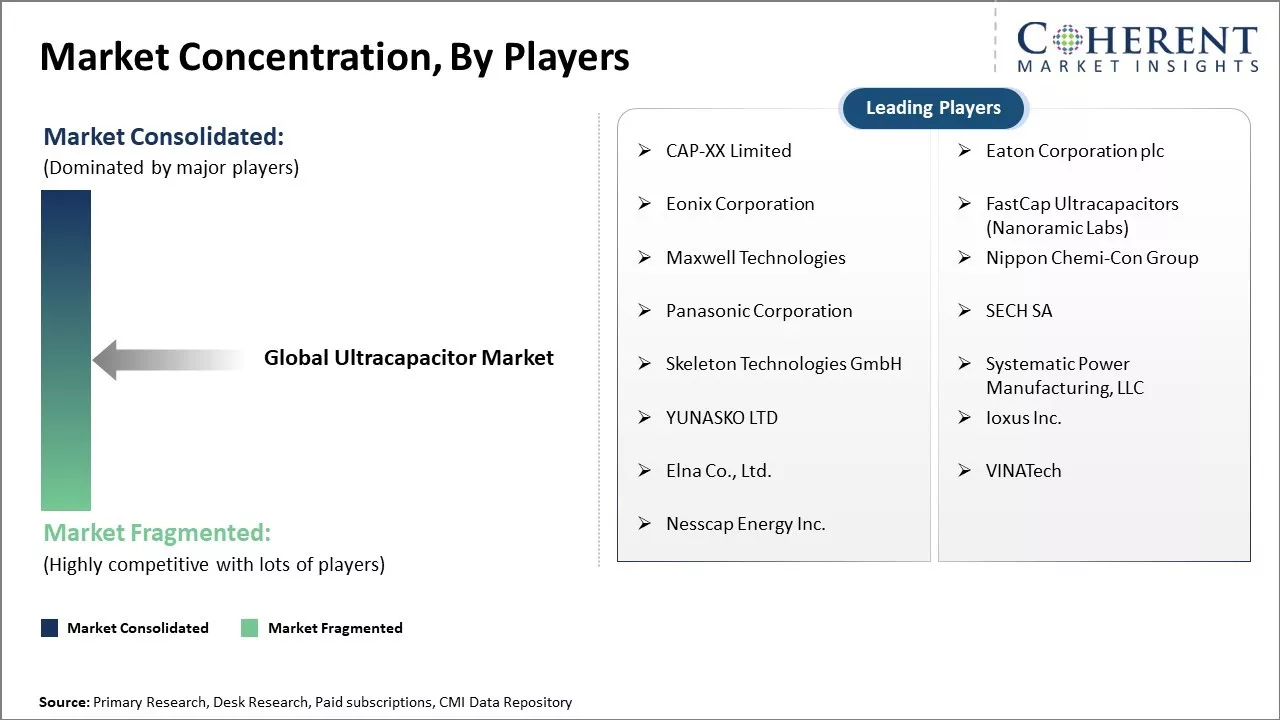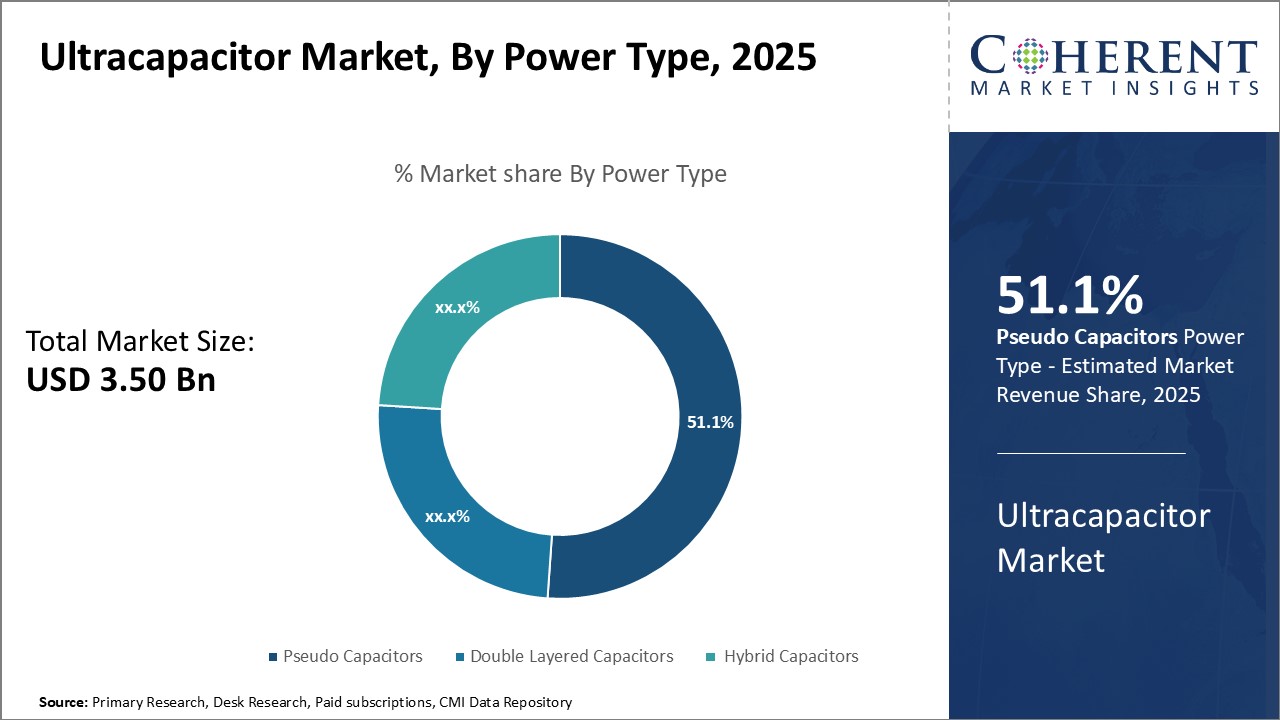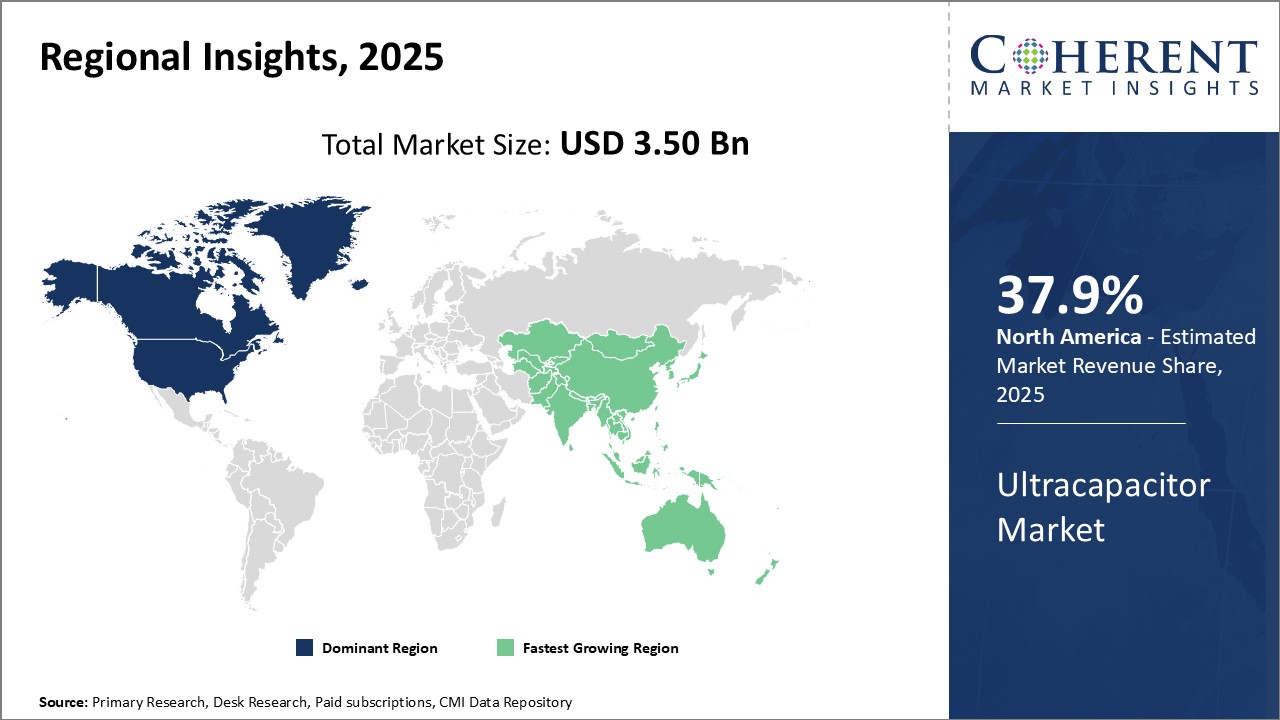The global ultracapacitor market is estimated to be valued at US$ 3.50 Bn in 2025 and is expected to reach US$ 9.77 Bn by 2032, exhibiting a compound annual growth rate (CAGR) of 15.8% from 2025 to 2032.

Discover market dynamics shaping the industry: Download Free Sample
The global ultracapacitor market is primarily driven by growing demand for electric vehicles and increasing implementation of renewable energy. Ultracapacitors are increasingly being used in electric vehicles and hybrid electric vehicles due to their fast-charging capability. They help to improve the efficiency and performance of electric vehicles. Moreover, growing emphasis on utilization of renewable energy is also augmenting the market growth. Ultracapacitors help to store excess energy produced from renewable energy sources such as solar and wind. They play a vital role in storing intermittent power from renewable sources and regulating voltage fluctuations. In addition, increasing research and development activities coupled with ongoing technological advancements in ultracapacitors are expected to offer new growth opportunities for the ultracapacitor market in upcoming years.
Drivers of the Market:
Environmental concerns driving demand for green energy solutions
Increasing concerns about climate change and its devastating effects on the environment are driving the demand for clean and sustainable energy solutions across the globe. Ultracapacitors are being widely recognized as one such promising green technology due to their higher power density and longer lifecycles compared to traditional batteries. They allow for effective capture and storage of energy from various renewable sources such as solar, wind, and hydraulic without the need for routine replacements. This makes them a sustainable component for various applications involving renewable integration to the grid.
Many countries and organizations have now committed to ambitious climate targets that require aggressive deployment of renewable energy and transition away from fossil fuel based systems. Ultracapacitors can play a major role in stabilizing power fluctuations arising from the intermittent nature of many renewables. They help bridge the gaps between generation and demand while allowing for the better utilization of the harnessed clean power. Their higher cycle efficiency also ensures that more of the captured renewable energy can be fed back to the grid when needed. This has resulted in a growing focus on developing grids that leverage the capabilities of ultracapacitors to optimize renewable power usage. Rising environmental awareness among consumers and industries has further bolstered the incentive to explore such green storage technologies.

Get actionable strategies to beat competition: Download Free Sample
Growing demand for enhanced power delivery in transportation systems
Transportation accounts for a significant portion of global energy consumption and carbon emissions. The increased focus on developing more efficient and environment-friendly means of transportation has opened up new growth avenues for advanced storage devices like ultracapacitors. Their higher power density and longer operational lifetimes provide distinct advantages over lithium-ion batteries for applications requiring burst power capabilities. This includes buses, trucks, trains, and other heavy duty vehicles where high acceleration and regenerative braking create a major need for capacitors and supercapacitors to efficiently handle rapid discharging and recharging of power.
The push for the electrification of public transportation systems as well as commercial fleet vehicles in many nations is a major driver for ultracapacitor adoption. When integrated optimally with lithium-ion battery packs, they can improve performance through better torque delivery and longer battery life. The automotive industry is also exploring their utilization in start-stop systems, electric vehicles, and other auxiliary powered devices that require instant energy support. Even hybrid locomotives and trams are integrating ultracapacitors for superior power management during acceleration, braking, and other intensive operational cycles.
Key Takeaways from Analyst:
The global ultracapacitor market has strong growth potential over the next decade driven by the increasing demand for efficient energy storage solutions across various industries. As renewable energy infrastructure expands, ultracapacitors are well positioned to provide backup energy storage for intermittent power sources like solar and wind. Their high-power density and long cycle life make them an attractive replacement for lead-acid batteries commonly used in wind turbine and hybrid vehicle applications. On the industrial front, ultracapacitors could see growing adoption in discrete manufacturing to power automated guided vehicles and robots. However, high costs remain a restraint for wider commercialization compared to lithium-ion batteries. Technological innovations to lower component expenses will be critical for market growth.
The North America region currently dominates the ultracapacitor landscape and is expected to remain the fastest growing market over the forecast period. This can be attributed to the strong industrial growth and increasing investments in renewable energy sectors. Furthermore, the region is home to major ultracapacitor manufacturers like NEC Tokin and Maxwell Technologies which are undertaking strategic initiatives to boost domestic production. In the high-performance automotive segment, European markets are projected to witness significant demand fueled by stringency in vehicle emission norms promoting hybrid and electric vehicles adoption. Success of next-generation products with improved energy density could open up new opportunities in consumer electronics as well.
Market Challenges: High initial cost compared to alternatives
High initial cost compared to alternatives is one of the major factors restraining the growth of the global ultracapacitor market. Ultracapacitors are still relatively new energy storage devices and have much higher upfront costs than conventional alternatives like lithium-ion batteries. While ultracapacitors have advantages like longer lifetime, higher power density, and ability to charge and discharge much faster than batteries, their high purchase price is making customers hesitant to adopt them on a large scale. The cost of ultracapacitors depends on multiple factors like the manufacturing process, electrode material used, cell configuration and overall energy storage capacity.
Market Opportunities: Integration of ultracapacitors in smart devices and wearables
The integration of ultracapacitors in smart devices and wearables presents a major opportunity for growth in the global ultracapacitor market. Ultracapacitors offer several advantages over traditional batteries such as longer life cycle, faster charging capabilities, and the ability to withstand more charge-discharge cycles. As wearable devices and mobile electronics become increasingly powerful with more functionalities, there is a growing need for energy storage solutions that can handle their high power demands while maintaining compact form factors.
Ultracapacitors are well-suited to fulfill this need. As wearables integrate more health monitoring sensors, screens, and other power-hungry components, ultracapacitors can play a key role in ensuring these devices run smoothly throughout the day without frequent charging. Early adoption is already being seen in smart watches, fitness trackers, Bluetooth headphones, and other wearables that require short charge times and long battery backup. Meanwhile, the demand for versatile power sources from applications like drones, electric vehicles, and other robotics is pushing the development of high-performance ultracapacitors.

Discover high revenue pocket segments and roadmap to it: Download Free Sample
Insights By Power Type - Pseudo capacitors are anticipated to lead the market due to their exceptional energy density
Pseudo capacitors are expected to contribute 51.1% share of the market in 2025 owing to their superior energy density. Pseudo capacitors, also known as electrochemical double layer capacitors/, have emerged as the dominant power type in the global ultracapacitor market due to their high energy density. Unlike conventional double layer capacitors, pseudo capacitors are able to store and deliver more charge per unit volume through fast and reversible faradaic reactions at the electrode-electrolyte interface. This gives them significant advantages over other capacitor technologies for applications requiring bursts of power.
A key factor driving the growth of pseudo capacitors is the increasing demand for batteries with higher charge/discharge rates from industries like automotive and consumer electronics. Pseudo capacitors can charge and discharge several orders of magnitude faster than lithium-ion batteries, allowing devices to be powered within seconds. Their greater power handling capabilities make them well-suited for regenerative braking systems in hybrid and electric vehicles. Many automakers are integrating pseudo capacitors into braking modules to recover kinetic energy lost during deceleration more efficiently.
Another major factor is their longer cycle life and thermal stability compared to batteries. Pseudo capacitors can undergo hundreds of thousands of charge/discharge cycles without significant capacity loss. They also have an operating temperature range from -40°C to 65°C, giving them an advantage in extreme climate applications. This reliability and durability is important for mission-critical use cases in industries such as renewable energy, transportation, and heavy machinery.
Continued advancements in electrode materials is also driving the adoption of pseudo capacitors. New materials like transition metal oxides and conductive polymers are able to store even more charge through fast faradaic reactions. This promises to further enhance pseudo capacitors' energy attributes over double layer and hybrid capacitors. As these materials mature, pseudo capacitors are poised to capture an even greater share of the ultracapacitor market.
Insights By Application - The automotive sector is projected to take the lead in the market, fueled by the growing trend of electrification
The automotive segment dominates the global ultracapacitor market with 43.8% share in 2025 driven primarily by the increasing electrification of vehicles. Ultracapacitors offer several benefits over lithium-ion batteries for the automotive and transportation applications, making them an attractive energy storage solution.
Their high power density enables ultracapacitors to deliver bursts of power needed for battery assist functions like start-stop systems, regenerative braking, and accelerating. As automakers aim to reduce weight and improve fuel economy, ultracapacitors are a compelling technology for recovering kinetic energy lost during braking and reusing it for the next acceleration. They allow electric vehicles to recharge in seconds from braking, extending the driving range.
Ultracapacitors also have a longer lifespan than batteries, with up to a million charge-discharge cycles. This durability is well-suited for electric buses and trucks that run continuously and require replacement-free energy storage. Their ability to work at wide temperature ranges from -40°C to 65°C also gives them an edge in harsh operating environments like commercial vehicles, rail, and off-road machinery.
Rising environmental awareness and stringent emission regulations are prompting automakers to develop more hybrid, plug-in hybrid, and electric vehicles. Ultracapacitors play a vital role in improving the efficiency and drivability of these electrified vehicles. As electric powertrains become mainstream, ultracapacitors are poised to grow in prominence due to their compatibility with next-generation automotive technologies.

Need a Different Region or Segment? Download Free Sample
North America has firmly established itself as the dominant region in the global ultracapacitor market. The region is expected to account for 37.9% of the market share in 2025. The U.S. accounts for the largest share due to the strong manufacturing presence of prominent players and high demand from industries such as transportation and renewable energy. American companies like Eaton, Maxwell Technologies, and Skeleton Technologies are leaders in capacitor technology innovation and hold significant patents. They also actively engage in R&D to develop advanced supercapacitors catering to different applications.
Growing focus on electrified transportation in the form of electric vehicles and hybrid buses is propelling the demand for capacitors from the automotive sector. Meanwhile, increasing installations of wind and solar energy farms is another key growth driver as ultracapacitors help stabilize power generated from renewable sources. The presence of major end-use industries and supportive government policies toward clean technologies give the regional North America ultracapacitor market an edge over others.
Asia Pacific, on the other hand, has emerged as the fastest growing market worldwide on account of rising industrial and economic activities across developing nations. China contributes greatly due to its gigantic manufacturing sector and government incentives for developing energy storage technologies. Local players, such as Nantong Jianghai Capacitor, manufacture various capacitor types at low costs to fulfill domestic needs.
Countries like India and Southeast Asia are also displaying high import and export volumes of ultracapacitors. The components are extensively used in industrial machinery, electronics, and intermittent power back-up systems. Expanding middle-class population and increasing foreign investments into infrastructure and energy sectors provide immense opportunities for capacitor suppliers. Along with an abundant skilled workforce, Asia Pacific offers ultracapacitor producers favorable conditions to establish production facilities and cater to growing demands.
Ultracapacitor Market Report Coverage
| Report Coverage | Details | ||
|---|---|---|---|
| Base Year: | 2024 | Market Size in 2025: | USD 3.50 Bn |
| Historical Data for: | 2020 To 2024 | Forecast Period: | 2025 To 2032 |
| Forecast Period 2025 to 2032 CAGR: | 15.8% | 2032 Value Projection: | USD 9.77 Bn |
| Geographies covered: |
|
||
| Segments covered: |
|
||
| Companies covered: |
CAP-XX Limited, Eaton Corporation plc, Eonix Corporation, FastCap Ultracapacitors (Nanoramic Labs), Maxwell Technologies, Nippon Chemi-Con Group, Panasonic Corporation, SECH SA, Skeleton Technologies GmbH, Systematic Power Manufacturing, LLC, YUNASKO LTD, Ioxus Inc., Elna Co., Ltd., VINATech, and Nesscap Energy Inc. |
||
| Growth Drivers: |
|
||
| Restraints & Challenges: |
|
||
Uncover macros and micros vetted on 75+ parameters: Get instant access to report
*Definition: The global ultracapacitor market involves the manufacturing and sales of ultracapacitor devices globally. Ultracapacitors, also known as supercapacitors, are energy storage devices that have higher power density than electrolytic capacitors but lower than rechargeable batteries. They are used across industries like automotive, industrial, electronics, and energy where rapid charge-discharge capabilities are required. The global ultracapacitor market is expected to grow significantly in the coming years due to increasing demand for devices and systems requiring higher power density and longer lifespan than batteries can provide.
Share
Share
About Author
Suraj Bhanudas Jagtap is a seasoned Senior Management Consultant with over 7 years of experience. He has served Fortune 500 companies and startups, helping clients with cross broader expansion and market entry access strategies. He has played significant role in offering strategic viewpoints and actionable insights for various client’s projects including demand analysis, and competitive analysis, identifying right channel partner among others.
Missing comfort of reading report in your local language? Find your preferred language :
Transform your Strategy with Exclusive Trending Reports :
Frequently Asked Questions
Joining thousands of companies around the world committed to making the Excellent Business Solutions.
View All Our Clients